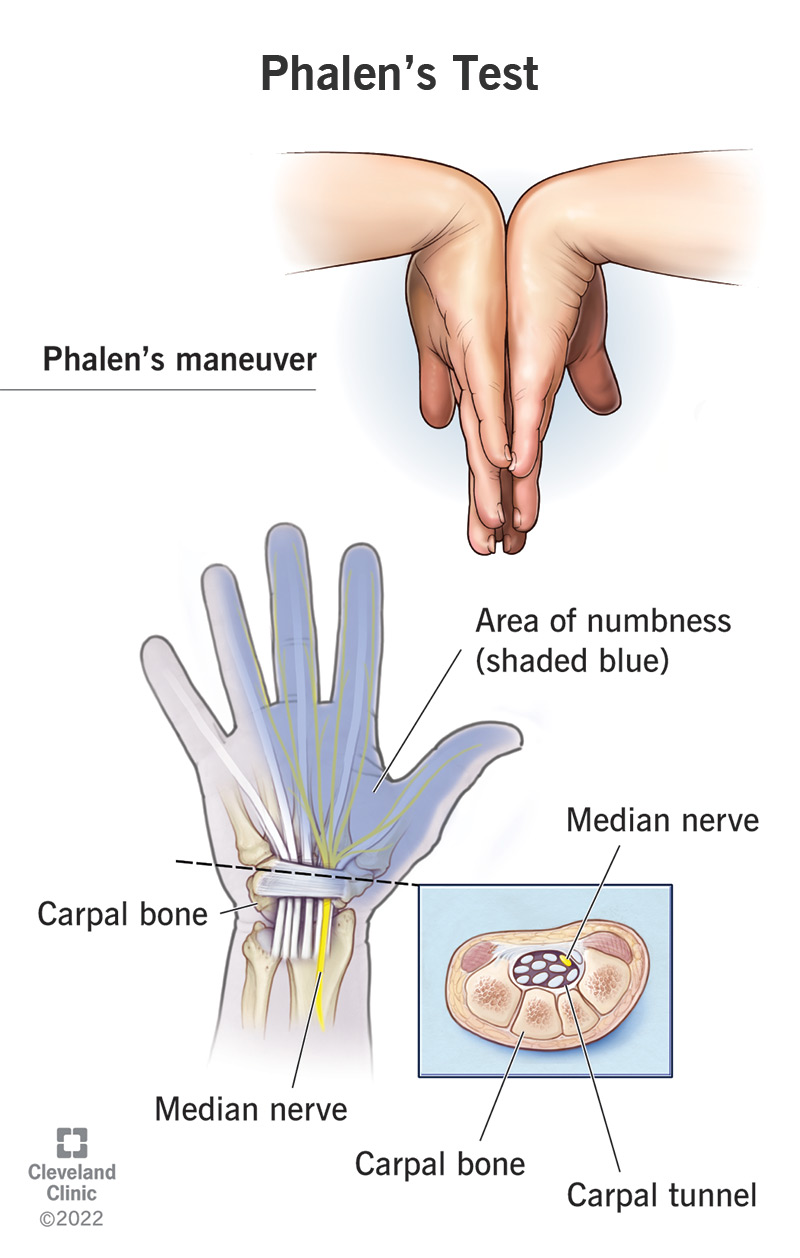Phalen’s test is a series of movements and positions that help your healthcare provider diagnose carpal tunnel syndrome. You’ll move your hands and wrists into a position that puts light pressure on the median nerve in your wrist. If you feel tingling or numbness in your hands or fingers, you probably have carpal tunnel syndrome.
Advertisement
Cleveland Clinic is a non-profit academic medical center. Advertising on our site helps support our mission. We do not endorse non-Cleveland Clinic products or services. Policy

Phalen’s test is a series of hand and wrist movements and positions healthcare providers use to diagnose carpal tunnel syndrome. You might see it referred to as Phalen’s sign or the Phalen’s maneuver. Providers use these names interchangeably.
Advertisement
Cleveland Clinic is a non-profit academic medical center. Advertising on our site helps support our mission. We do not endorse non-Cleveland Clinic products or services. Policy
It’s an in-office physical exam, which means a provider can perform it without any special equipment or a separate appointment. Your provider will ask you to hold your hands and wrists in different positions that put light pressure on the median nerve in your wrist. If any of these movements make you feel tingling or numbness, it’s usually a good indicator that you have carpal tunnel syndrome.
You might need an imaging test to confirm that you have carpal tunnel syndrome or to identify irritation inside your wrist.
You might need the Phalen’s test if a provider thinks you have carpal tunnel syndrome. If you visit a provider with wrist pain or other symptoms in your hands and fingers, they might have you perform a Phalen’s test as part of your physical exam.
Carpal tunnel syndrome is one of the most common conditions that affect people’s hands and wrists. The carpal tunnel is formed by the bones in your wrist that lets tendons, ligaments and nerves pass through it to reach the rest of your hand. Carpal tunnel syndrome happens when something irritates or puts extra pressure on the median nerve that runs through your carpal tunnel.
You’ll perform the motions and hand positions that makeup Phalen’s test. You won’t use any special equipment or need to prepare. Your provider will show you how to position your arms, hands and wrists correctly. They’ll supervise you while you hold your hands in those positions.
Advertisement
The different positions of the Phalen’s test put light pressure on your carpal tunnel. Tell your provider if any part of the Phalen’s test is painful or makes you uncomfortable.
The test is simple and includes the following hand and wrist positions:
The reverse Phalen’s test is very similar to the Phalen’s test. It’s a different set of motions and hand positions that also check for symptoms of carpal tunnel syndrome. Your provider might have you perform one or both tests during your exam.
The steps to perform a reverse Phalen’s test include:
You don’t have to do anything to prepare for a Phalen’s test. Visit a provider if you notice new symptoms in your wrist, hands or fingers.
Try to perform the motions and hold the positions as long as your provider asks. You might feel some discomfort or tingling if you have carpal tunnel syndrome, but you shouldn’t feel intense pain.
After the Phalen’s test, you might need an imaging test to take pictures of the inside of your wrist, hand or nerves, including:
If you have carpal tunnel syndrome, your provider will treat it. They’ll tell you which treatments you’ll need and what to expect. If you need surgery to repair damage inside your wrist, you’ll see an orthopaedist.
There aren’t any risks to either type of the Phalen’s test.
You might feel a little pain or discomfort during the test. But — even if you have carpal tunnel syndrome — the test is fast, and you can stop if you’re extremely uncomfortable. Tell your provider if any of the motions or positions in the test hurt.
Your provider will classify your Phalen’s test results as positive or negative. A positive Phalen’s test means that you had some symptoms of carpal tunnel syndrome during the test. A negative Phalen’s test means you held the positions without experiencing any carpal tunnel syndrome symptoms.
Advertisement
Phalen’s test is usually very accurate, but there’s a chance you have carpal tunnel syndrome even if you have a negative Phalen’s test. Studies have found that the test is more than 85% accurate if you hold the hand position for more than a minute. However, Phalen’s test is only part of your overall physical exam. Tell your provider about when you notice symptoms and how severe they are.
The Phalen’s test and Tinel’s sign are both in-office physical tests a healthcare provider might use to diagnose carpal tunnel syndrome in your wrist.
Phalen’s test is a series of hand motions and positions that will make your hands or fingers feel numb or tingly if you have carpal tunnel syndrome.
Tinel’s sign is a tingling feeling you get when your healthcare provider taps your skin over an affected nerve. If your provider thinks you have carpal tunnel syndrome, they’ll tap on your skin above the median nerve in your wrist. If that light pressure creates a tingling or “pins-and-needles” feeling in your fingers, you might have carpal tunnel syndrome or another form of nerve compression.
The Phalen’s test is a quick, simple set of hand and wrist positions a healthcare provider will use to help diagnose carpal tunnel syndrome. You don’t have to do anything special to prepare, and the test itself is very fast. Visit a provider if you’re experiencing new wrist pain or notice symptoms like tingling or numbness in your hands or fingers.
Advertisement
From sudden injuries to chronic conditions, Cleveland Clinic’s orthopaedic providers can guide you through testing, treatment and beyond.

Last reviewed on 07/18/2023.
Learn more about the Health Library and our editorial process.